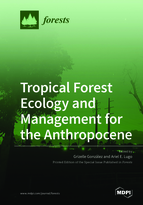Tropical Forest Ecology and Management for the Anthropocene
A special issue of Forests (ISSN 1999-4907).
Deadline for manuscript submissions: closed (31 March 2017) | Viewed by 101868
Special Issue Editors
Interests: tropical soil ecology; biology and biogeochemistry; disturbance effects; wood and litter decay; role of soil organisms in ecosystem processes and functions
Special Issues, Collections and Topics in MDPI journals
Interests: tropical forests including mangroves, forested wetlands, and urban forests; ecosystem functioning including productivity, nutrient cycling, succession, and response to natural and anthropogenic disturbances; social-ecological studies including natural processes of novelty and emerging novel ecosystems
Special Issue Information
Dear Colleagues,
This Special Issue takes both a historical and a future outlook to the conservation challenges of the Caribbean, based on 75 years of research and applications by the International Institute of Tropical Forestry. It transforms Holocene-based scientific study of the tropics into Anthropocene applications and outlooks in wilderness, managed forests, and urban environments. Urban topics include how cities think, and using green infrastructure for improving human health and city functioning. Policies relevant to the Anthropocene, as well as the use of experiments to learn about the future response of tropical forests to global warming, are included. Long-term results and applications of research in topics such as freshwater streams, soil biota, migratory birds, tropical vegetation, soil biogeochemistry, and the tropical carbon cycle are also included.
Dr. Grizelle González
Dr. Ariel E. Lugo
Guest Editors
Manuscript Submission Information
Manuscripts should be submitted online at www.mdpi.com by registering and logging in to this website. Once you are registered, click here to go to the submission form. Manuscripts can be submitted until the deadline. All submissions that pass pre-check are peer-reviewed. Accepted papers will be published continuously in the journal (as soon as accepted) and will be listed together on the special issue website. Research articles, review articles as well as short communications are invited. For planned papers, a title and short abstract (about 100 words) can be sent to the Editorial Office for announcement on this website.
Submitted manuscripts should not have been published previously, nor be under consideration for publication elsewhere (except conference proceedings papers). All manuscripts are thoroughly refereed through a single-blind peer-review process. A guide for authors and other relevant information for submission of manuscripts is available on the Instructions for Authors page. Forests is an international peer-reviewed open access monthly journal published by MDPI.
Please visit the Instructions for Authors page before submitting a manuscript. The Article Processing Charge (APC) for publication in this open access journal is 2600 CHF (Swiss Francs). Submitted papers should be well formatted and use good English. Authors may use MDPI's English editing service prior to publication or during author revisions.







